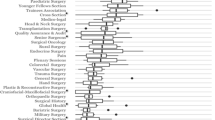Abstract
Purpose
Grand rounds are an opportunity for invited or internal speakers to disseminate clinical knowledge and research. Prior research has shown that the percentage of female grand rounds speakers across departments has traditionally been lower than the female proportion of faculty and trainees. This study aims to characterize trends and relationships between grand rounds presentation topics and speaker demographics.
Methods
General surgery grand rounds presentations between 2016 and 2021 at our institution were reviewed. For each presentation, speaker gender and institution were coded. Three reviewers performed a content analysis of topics by developing subcategories and collapsing these into larger categories upon final review.
Results
Of the 177 speakers reviewed from 2016 to 2020, 21.47% were females (n = 44), which was not significantly different from the percentage of female faculty (p value = 0.373). The most common topics were “Basic,
Translational, and Clinical Research” (n = 44, 24.8%), and “Care of Specific Conditions” (n = 42, 23.7%). The categories with the largest percentage of female speakers were “Diversity, Equity and Inclusion (DEI)” (57%) and “Global and Population Health” (60%). When dichotomizing presentation topics into DEI vs. non-DEI, chi-squared analysis demonstrated a significant association between gender and whether the presentation was on DEI (Chi squared = 1.236, df = 1, p value = 0.266).
Conclusions
In this single-institution analysis, there is a statistically significant difference between the number of female speakers and male speakers who discuss diversity, equity, and inclusion. This study demonstrates the need for improved representation of female speakers on non-DEI topics.


Similar content being viewed by others
Data availability
Data are available on request due to privacy or other restrictions.
References
Wright SM, Carrese JA. Serving as a physician role model for a diverse population of medical learners. Acad Med. 2003;78(6):623–8.
Colleges, A.A.o.M. ACGME residents and fellows by sex and specialty. 2019.
Colleges, A.A.o.M. Active Physicians by Sex and Specialty. 2019. Available from: https://www.aamc.org/data-reports/workforce/interactive-data/active-physicians-sex-and-specialty-2019. Accessed Mar 2022
Lyons NB, et al. Gender disparity in surgery: an evaluation of surgical societies. Surg Infect. 2019;20(5):406–10.
Bernardi K, et al. Gender disparity among surgical peer-reviewed literature. J Surg Res. 2020;248:117–22.
Boiko JR, Anderson AJ, Gordon RA. Representation of women among academic grand rounds speakers. JAMA Intern Med. 2017;177(5):722–4.
Gharzai LA, et al. Speaker introductions at grand rounds: differences in formality of address by gender and specialty. J Womens Health. 2022;31(2):202–9.
O’Brien BC, et al. Standards for reporting qualitative research: a synthesis of recommendations. Acad Med. 2014;89(9):1245–51.
Buell D, Hemmelgarn BR, Straus SE. Proportion of women presenters at medical grand rounds at major academic centres in Canada: a retrospective observational study. BMJ Open. 2018;8(1): e019796.
Carr PL, et al. Gender differences in academic medicine: retention, rank, and leadership comparisons from the national faculty survey. Acad Med. 2018;93(11):1694–9.
Silver JK, et al. Where are the women? The underrepresentation of women physicians among recognition award recipients from medical specialty societies. Pm r. 2017;9(8):804–15.
Jagsi R, et al. Gender differences in the salaries of physician researchers. JAMA. 2012;307(22):2410–7.
Jagsi R, et al. The “gender gap” in authorship of academic medical literature–a 35-year perspective. N Engl J Med. 2006;355(3):281–7.
AAMC. U.S. Medical School Faculty by Sex and Rank, 2018. 2018 [cited 2022 May 5].
Modra LJ, et al. Female representation at Australasian specialty conferences. Med J Aust. 2016;204(10):385.
Casadevall A, Handelsman J, Miller JF. The presence of female conveners correlates with a higher proportion of female speakers at scientific symposia. MBio. 2014;5(1):e00846-e913.
Nittrouer CL, et al. Gender disparities in colloquium speakers at top universities. Proc Natl Acad Sci USA. 2018;115(1):104–8.
Lyons NB, et al. Gender disparity in surgery: an evaluation of surgical societies. Surg Infect (Larchmt). 2019;20(5):406–10.
How Duke Compares: General Surgery Residency Program. 2022 [cited 2022 May 5].
AAMC. Active Physicians by Sex and Specialty, 2017. 2017 [May 5, 2022].
Sharpe EE, et al. Representation of women among invited speakers for grand rounds. J Womens Health (Larchmt). 2020;29(10):1268–72.
Metaxa V. Is this (still) a man’s world? Crit Care. 2013;17(1):112.
Files JA, et al. Speaker introductions at internal medicine grand rounds: forms of address reveal gender bias. J Womens Health (Larchmt). 2017;26(5):413–9.
Author information
Authors and Affiliations
Corresponding author
Ethics declarations
Conflict of interest
The authors did not receive support from any organization for the submitted work.
Rights and permissions
Springer Nature or its licensor (e.g. a society or other partner) holds exclusive rights to this article under a publishing agreement with the author(s) or other rightsholder(s); author self-archiving of the accepted manuscript version of this article is solely governed by the terms of such publishing agreement and applicable law.
About this article
Cite this article
Biswas, S., Stauffer, T., Grant, C. et al. A qualitative content analysis of general surgery grand rounds speaker demographics and topics of presentation. Global Surg Educ 2, 67 (2023). https://doi.org/10.1007/s44186-023-00124-6
Received:
Revised:
Accepted:
Published:
DOI: https://doi.org/10.1007/s44186-023-00124-6




